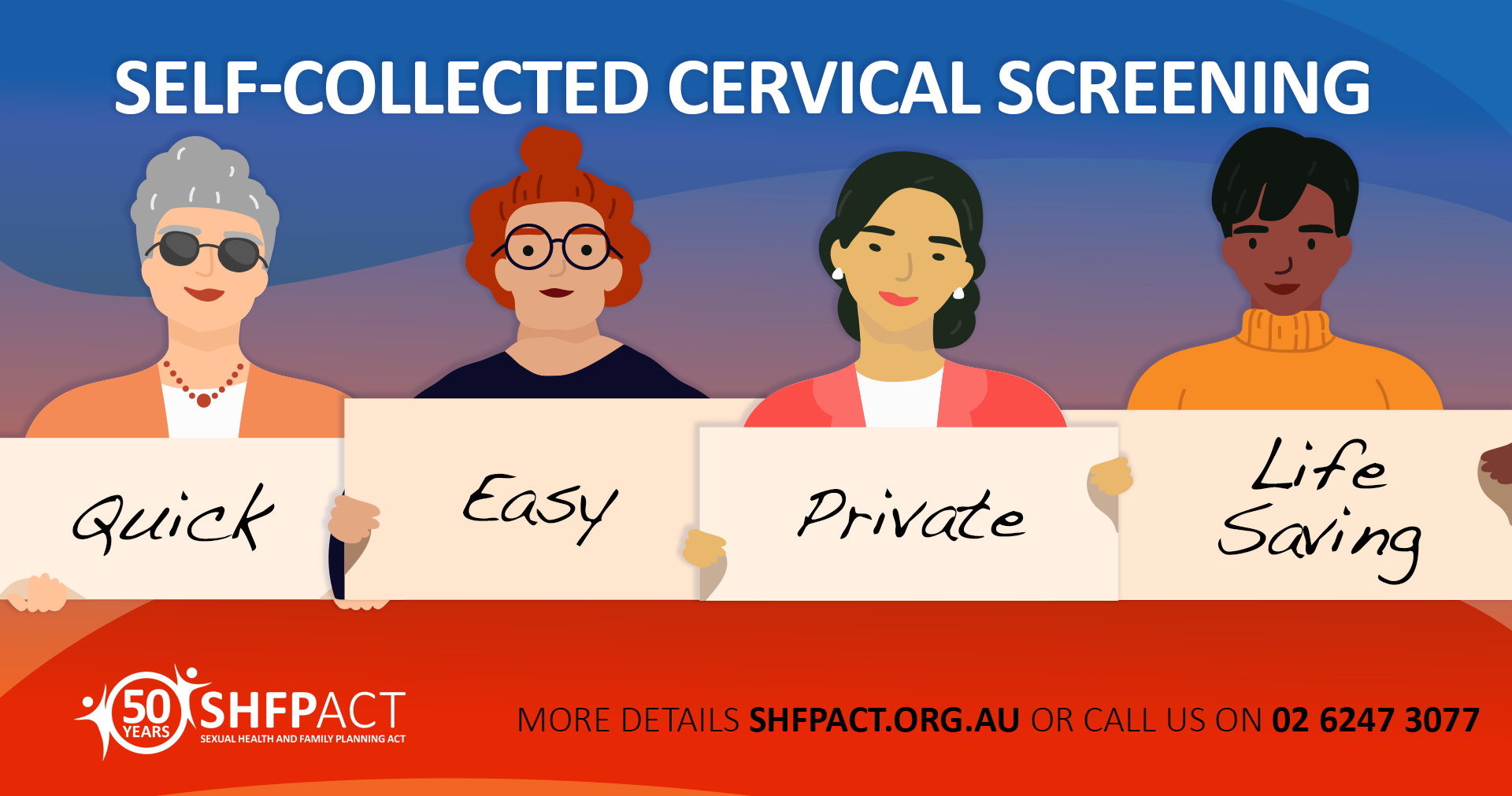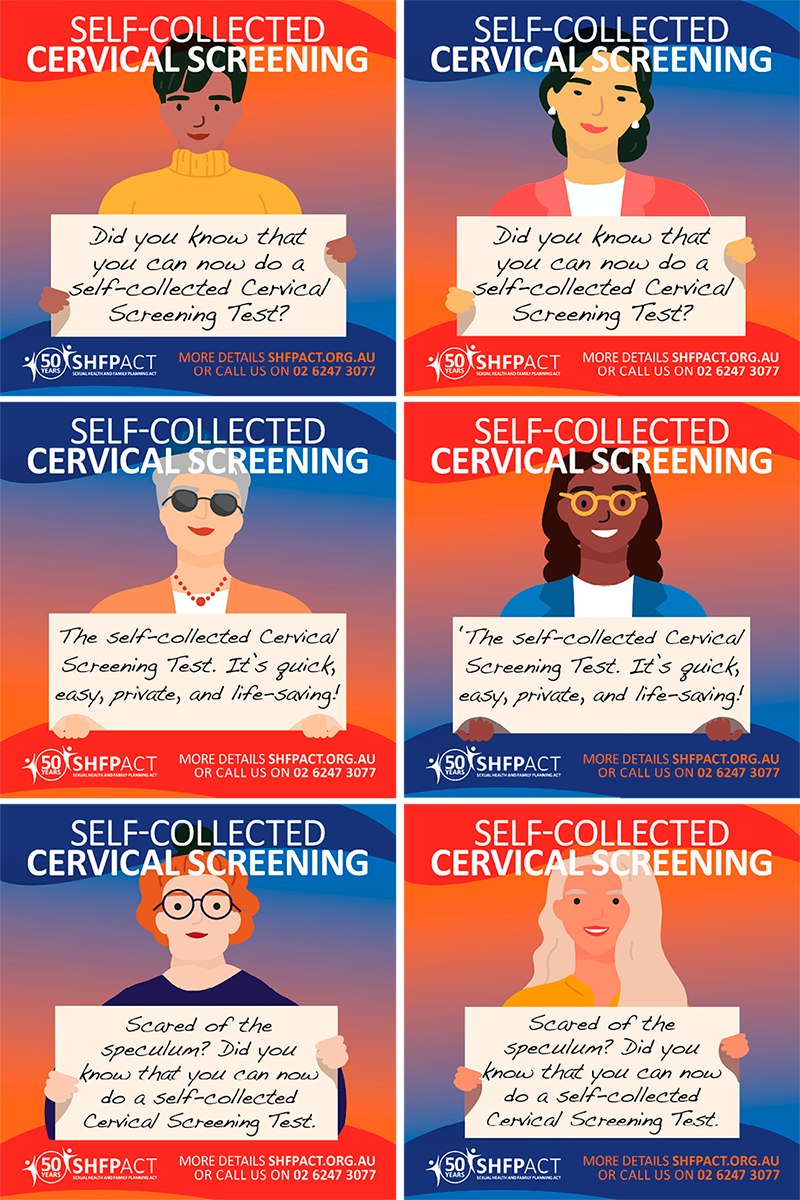
Cervical Screening : Impact Over Time: Case Study
The way SHFPACT has responded to and promoted important changes in medical technology and innovation in healthcare provision, through its direct clinical services, its focus on skilling the health and health promotion workforce, and community education and information services, provides an exemplar of how the edge of our work is always moving in the right direction to achieve our purpose of improving sexual and reproductive health and rights in the Canberra community.
We adapt the scope of our services, our health information and health promotion activities, and our education and training focus to reflect the evidence changing needs, and to position our work to be contributing to the known and emerging issues we are best placed to address.
Cervical screening services have been a core of SHFPACT’s clinical services, workforce development activities and health promotion efforts for decades. For a long time, screening services have been delivered substantially by our experienced sexual and reproductive health nurses at SHFPACT, working alongside medical officers who generally focus more on services where people have symptoms.
SHFPACT has a positive reputation in the community for skilled, confident and supportive healthcare. And our training programs over decades share these skills with practice nurses across the Capital region, helping to ensure people get safe, supportive and skilled care for this important cancer prevention screening service.
Cervical cancer affects the cells of the cervix (the lower part of the uterus/womb — located at the top of the vagina). Cervical cancer develops when abnormal changes occur in the cells of the cervix and precancerous lesions develop. These precancerous lesions, if left undetected and untreated, can progress to cancer which can in turn spread into the surrounding tissue.
It can take up to 10 to 20 years for cervical cancer to develop. The majority (over 99.7%) of cervical cancer is caused by cancer causing strains of the human papilloma virus (HPV). HPV is a large group of viruses which infect humans.
Since the introduction of the National Cervical Screening Program in 1991, cervical cancer mortality rates have halved in Australia. Cervical cancer is one of the most preventable and treatable forms of cancer. While Australia has had a highly effective cervical screening program which has reduced the incidence of cervical cancer significantly since its inception, participation has remained relatively unchanged over time.
Just over 6 in 10 people in the eligible target age group currently participate in the National Cervical Screening Program. The participation rate in the ACT was 70.9% in the period 2018-2022, reflecting an increase in the first cycle following introduction of new cervical screening guidelines in 2017.
Higher participation in cervical screening is directly correlated with reduced incidence and mortality from cervical cancer by detecting precancerous abnormalities that can be treated before any progression to cervical cancer occurs.
Rates of cervical cancer are significantly higher in people who have never screened or who are under screened (under screened or lapsed screeners are identified as those who are over two years overdue for their routine screening). At least 72% of people who develop cervical cancer are known to be under screened or never screened.

Australian research led to the creation of HPV vaccines against four and now nine of the human papilloma virus (HPV) variants most commonly linked with cervical and other cancers.
Most Australian young people receive this vaccination as part of the early high school years immunisation program. From 2006 when the vaccine was first rolled out in Australia, the SHFPACT clinic was a key local provider in the ‘catch-up’ program that offered free vaccination to young people with a cervix up to the age of 26.
Immunisation rates in Australia are globally respectable, at around 80% (lower for first nations adolescents), and slightly above the national average in the ACT at 86% for females (80.8% indigenous) and 80% for males (62.7% indigenous).
The introduction of HPV immunisation led directly a decade later to changes in our cervical screening guidelines. Between 1991-2017, cervical screening involved a test of pre-cancerous changes to cells collected from the cervix every two years, commonly referred to as a pap smear. Since 2017, cervical screening involves a test for the presence of human papilloma virus (HPV). This occurs much earlier in the aetiology of cervical cancer, allowing the testing interval to be safely increased to five years.
SHFPACT played an important role in the Canberra region raising health awareness and supporting primary healthcare providers to understand the significant changes in the Australian guidelines for cervical screening in 2017. Challenges in establishing new national registers and a couple of delays in the start of the new guidelines meant investment in public health education about the changes was slow, leaving family planning organisations and women’s health advocacy groups across Australia filling the critical role of reassuring the public that the increased testing interval was, in fact, safer than the previous approach.
Australia’s immunisation and screening participation rates are a positive reflection of health system effort for the overall health of Australia’s population, but also reveal where there is still significant important work to do.
Not least, we see that vaccination reach for Aboriginal and Torres Strait Islander people still falls below, and this is one specific example of our need to maintain focus on closing the gap in health disadvantage and outcomes. We also have a very strong picture of the diversity of people who are unscreened and under screened, and at greatest risk of developing cervical cancer as a result.
We know, for example, that barriers to healthcare arising from social determinants of health are significant in this group. That prior experiences of intimate partners and sexual violence and other forms of trauma, including medical trauma, limit health service access.
We know that people who are gender diverse, who have differences in innate sex characteristics, and those who have had poor experiences attempting to engage in the health system previously are less likely to participate in cervical screening.
The game changer comes from another innovation in the Australian guidelines for cervical screening commenced in July 2022 — self-collect cervical screening tests becoming funded through Medicare for a much wider range of people in the community. This represents a major opportunity to lift our participation rates and continue to drive down incidence and mortality from cervical cancer.
Self-collect still involves interaction with a healthcare professional but allows the option for people to collect their own sample rather than have the doctor or nurse take the sample. This allows for cervical screening to be conducted in a much wider range of community locations, similar to outreach STI testing. This addresses a range of barriers for people to get to clinical care and allows for more opportunistic screening.
SHFPACT was ready for the new changes the moment they started. We had health promotion materials distributed into the community, and the clinical training team ran a webinar for health professionals that was attended by people across the country as well as from healthcare services here in Canberra.
In the first year of the new self-collect option, SHFPACT alone provided 31% of all the self-collect cervical screening tests in the ACT processed by our pathology provider (and 88% in the first month!).
As we look ahead, if we maintain and improve our immunisation and cervical screening participation rates, Australia is one of a few countries globally that is on track to see the elimination of cervical cancer as a public health concern by 2035. This won’t mean zero cervical cancer diagnoses ever, but it will see a reduction in the rate that will see it categorised as a rare cancer, with associated mortality falling below 1 in 100,000 population (currently estimated at 6 in 100,000). A global strategy to accelerate the elimination of cervical cancer was launched by the World Health Organisation in 2020. The Conquering Cancer Campaign is a global communications initiative to support all efforts to reduce cervical cancer worldwide.
Easy Quick Private Life Saving!
You can have a Cervical Screening Test with your regular GP, or you can book in to see one of our specially trained and highly experienced nurses at SHFPACT.
CALL 02 62473077 OR VIA HOTDOCS TO MAKE AN APPOINTMENT
Image Description: Six image-based illustration tiles of four different women holding signs that says. Quick. Easy. Private. Life-Saving. on a blue and orange background.
- Created on .
- Last updated on .